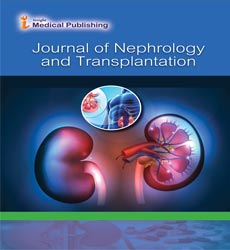Haemodialysis: An Interesting Experimental Model
Valeria Cernaro1*, Giuseppe Coppolino2 and Michele Buemi1
1Department of Clinical and Experimental Medicine, Nephrology and Dialysis Unit, University of Messina, Messina, Italy
2Nephrology and Dialysis Unit, "Pugliese-Ciaccio" General Hospital, Catanzaro, Italy
- *Corresponding Author:
- Valeria Cernaro
Department of Clinical and Experimental
Medicine, Nephrology and Dialysis Unit
University of Messina, Italy
Tel: +39.090.2212396
Fax: +39.090.2212329
E-mail: valecern82@virgilio.it
Received Date: October 28, 2017 Accepted Date: October 28, 2017 Published Date: October 31, 2017
Citation: Valeria C, Coppolino G, Buemi M (2017) Haemodialysis: An Interesting Experimental Model. J Nephrol Transplant Vol.1: No.1: e002.
Editorial
Chronic kidney disease consists in the progressive impairment of renal function that, in some cases, evolves towards end-stage renal disease requiring replacement therapy (kidney transplantation, haemodialysis or peritoneal c).
Focusing on haemodialysis, it allows the removal of fluid excess and waste products of nitrogen metabolism and is able to restore electrolyte and acid-base balance through different extracorporal techniques of blood purification [1].
Beyond the well-known effects on the most common biochemical parameters we routinely measure in our patients, haemodialysis also modifies serum levels of many other molecules, unknown or currently under investigation, including uraemic toxins as well as mediators of pathophysiological mechanisms or biomarkers of disease. Therefore, dialysis may be considered as a very interesting experimental model to evaluate the acute effects of the rapid change in serum concentrations of substances that are influenced by the treatment during each session depending on the haemodialyzer and the technique employed. This approach would allow a better understanding of the pathophysiology of uremic syndrome and dialysis-related complications and could be also useful to better compare with each other the different dialysis methods today available for the treatment of end-stage renal disease.
For example acetate-free biofiltration (AFB), a low-volume diffusive-convective dialysis technique, seems able to remove fibroblast growth factor (FGF)-23 [2] more effectively compared to conventional haemodialysis [3]. This may suggest that convective treatments could help reduce FGF-23 levels together with an appropriate nutritional and pharmacological management of calcium-phosphate metabolism, with potential benefits regarding systemic inflammation and cardiovascular morbidity and mortality [4,5].
Moreover, AFB affects the serum levels of mediators, such as apelin or relaxin-2, which have a role in the regulation of blood pressure and whose changes during a single dialysis session (apelin increase, relaxin-2 decrease) seem to be involved in the pathogenesis of intradialytic hypotension or hypertension respectively [6,7].
Another study demonstrated the ability of high cut-off dialysis to remove many immune mediators more efficiently compared to high-flux treatment [8], and this could reduce the chronic systemic inflammation that is typical of uraemic patients on dialysis and has been related to mortality and cardiovascular events [9].
In conclusion, haemodialysis is able to modify blood composition beyond what is known so far, with potentially relevant consequences. Then, the assessment of molecules of interest before and after treatment, with proper correction of post-dialysis values for haemoconcentration, could provide important clinical insights on the effects of extracorporeal therapies in patients with end-stage renal disease. Moreover, randomized clinical trials evaluating the impact of different dialysis techniques on serum levels of new biomarkers in addition to the already known biochemical parameters are strongly encouraged, in order to more deeply understand the reasons underlying the still high morbidity and mortality rate of patients receiving dialysis, despite the technological advances occurred in recent years [10], and to ameliorate dialysis methods and prescriptions with the aim to reduce the incidence of intra- and interdialytic complications and improve clinical outcomes.
References
- Nistor I, Palmer SC, Craig JC, Saglimbene V, Vecchio M, et al. (2015) Haemodiafiltration, haemofiltration and haemodialysis for end-stage kidney disease. Cochrane Database Syst Rev 20: CD006258.
- Cernaro V, Lucisano S, Canale V, Bruzzese A, Caccamo D, et al. (2017) Acetate-free biofiltration to remove fibroblast growth factor 23 in hemodialysis patients: a pilot study. J Nephrol 30: 1-5
- Yamamoto T, Nascimento MM, Hayashi SY, Qureshi AR, Waniewski J, et al. (2013) Changes in circulating biomarkers during a single hemodialysis session. Hemodial Int 17: 59-66.
- Sharaf El-Din UA, Salem MM, Abdulazim DO (2017) FGF23 and inflammation. World J Nephrol 6: 57-58.
- Grabner A, Mazzaferro S, Cianciolo G, Krick S, Capelli I, et al. (2017) Fibroblast growth factor 23: Mineral metabolism and beyond. Contrib Nephrol 190: 83-95.
- Cernaro V, Lacquaniti A, Lorenzano G, Loddo S, Romeo A, et al. (2012) Plasmatic osmolality and hypotension in dialyzed patients. Blood Purif 33: 317-323.
- Cernaro V, Lacquaniti A, Giorgianni G, Bolignano D, Buemi M (2013) Modifications in relaxin's serum levels during acetate-free biofiltration (AFB): Only a new biomarker? Ital J Anat Embryol 118: 98-99.
- Girndt M, Fiedler R, Martus P, Pawlak M, Storr M, et al. (2015) High cut-off dialysis in chronic haemodialysis patients. Eur J Clin Invest 45: 1333-1340.
- Cafka M, Rroji M, Seferi S, Barbullushi M, Burazeri G, et al. (2016) Inflammation, left ventricular hypertrophy, and mortality in end-stage renal disease. Iran J Kidney Dis 10: 217-223.
- Dai L, Golembiewska E, Lindholm B, Stenvinkel P (2017) End-stage renal disease, inflammation and cardiovascular outcomes. Contrib Nephrol 191: 32-43.
Open Access Journals
- Aquaculture & Veterinary Science
- Chemistry & Chemical Sciences
- Clinical Sciences
- Engineering
- General Science
- Genetics & Molecular Biology
- Health Care & Nursing
- Immunology & Microbiology
- Materials Science
- Mathematics & Physics
- Medical Sciences
- Neurology & Psychiatry
- Oncology & Cancer Science
- Pharmaceutical Sciences
